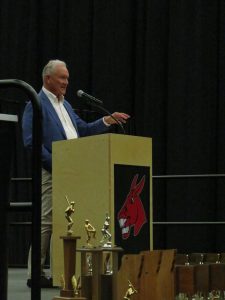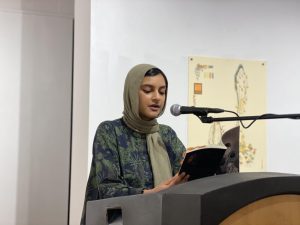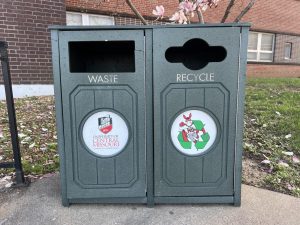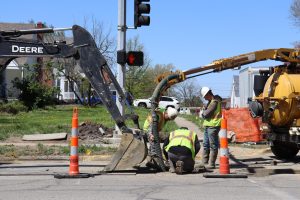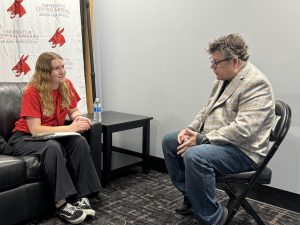Super Bowl LVI Halftime Show Increases Representation to Feature Great Music But Lacks Accessibility
February 25, 2022
Super Bowl LVI was a very highly anticipated spectacle, not only for the matchup between the Los Angeles Rams and the Cincinnati Bengals but also for the stacked halftime show lineup. Featuring Snoop Dogg, Dr. Dre, Eminem, Kendrick Lamar, Mary J. Blige and 50 Cent, this halftime show was certainly one of the most electric halftime performances in recent years. Aside from the Ram’s winning score, another victory that took place during the game was an increase in representation for the Deaf community. Sandra Frank, a Deaf actress, performed the “The Star-Spangled Banner” and “America the Beautiful,” while Mickey Guyton verbally sang, and Dr. Dre added two Deaf rappers to the show lineup, Sean Forbes and Warren “WaWa” Snipe.
According to the National Association of the Deaf’s website, “Wawa wowed the world with his ASL rendition of the National Anthem and “America the Beautiful,” with his performance viewed by more than 8 million people. Wawa has been a trailblazer as an acclaimed recording artist in the Hip Hop world and developed his own niche — Dip Hop, which he defines as Hip Hop through deaf eyes.
Plus, there were four Deaf football players from the California School for the Deaf that were chosen as honorary captains for the Super Bowl. The Super Bowl LVI halftime show saw a tremendous increase in viewership with 29 million different households tuning in according to Forbes.
The show began with a shot of Dr. Dre rising up to the roof of one of the 3 prop houses in which the artists performed in and on top of. “The Next Episode” from Dr. Dre’s “2001” album began playing, and Snoop Dogg appeared on the roof of the opposite prop house. As the pair performed “The Next Episode,” the audience went crazy for the local west-coast superstars, Dr. Dre being from Compton and Snoop Dogg being from Long Beach. This was a very awe-inspiring moment for fans of classic west-coast hip-hop.
As the show rolled on, the audience witnessed a surprise performance of “In Da Club” by 50 Cent. This was perhaps the most comical moment of the show, as 50 Cent appeared on screen hanging upside down in one of the buildings, as he did in the “In Da Club” music video.
After “In Da Club,” it was Mary J. Blige’s time to shine. The R&B legend was shown on screen on top of one of the houses performing “Family Affair” and “No More Pain.” This was a pivotal moment of the show, as Blige’s singing became more and more intense with every “No more pain.”
Following Blige was Kendrick Lamar. Instead of performing on or in the prop houses, like the rest of the artists, Lamar was on the field, which was covered in a satellite map of Los Angeles. Surrounded by identically dressed dancers, Lamar performed the beginning of “m.A.A.d city.” Moving quickly into “Alright,” Lamar grabbed the audience’s attention with a striking performance and captivating dance moves. Kendrick Lamar’s performance ended with perhaps the most enthralling moment of the entire show, the appearance of Eminem.
Another shot of Dr. Dre on top of the prop house, and Eminem’s vocals in the background surely caught viewers attention. If not, Eminem’s entrance surely did. Blowing the roof off of one of the buildings and rising to the top of it, performing his verse from “Forgot About Dre.” Quickly transitioning into “Lose Yourself,” Eminem embraced the spotlight. With Anderson Paak on drums, Eminem flawlessly performed one of his all time greatest hits. After the song came to a close, Eminem took a knee. This was a very incredible moment in the show, as it was done very much like Colin Kaepernick’s signature kneel, which represented the fight against racial injustice in the U.S.
After a short Dr. Dre-led jam, the iconic chords of “Still DRE” rang out into SoFi Stadium. Snoop Dogg and Dr. Dre joined each other once again to close out the show.
While it’s noticeable that Eminem took the opportunity to represent his alliance to demonstrate the resistance against racial injustice, some of the viewers were disappointed with the lack of representation on other fronts. Although Deaf people were going to be a part of the halftime show, Deaf, Hard of Hearing and DeafBlind audience members couldn’t see the performances of the Deaf artist on mainstream media. They had to navigate to another website or app, such as DPAN.tv, Vimeo and NBC Sports app, to view the livestream.
The few seconds that Frank was aired, there was an individual in the way, obstructing the view. A more inclusive show would’ve had the Deaf artist within proximity to the hearing artists while performing. According to the online article on iHeartradio, they were supposed to be on stage, not off to the sidelines – “Two deaf rappers, Sean Forbes and Warren “WaWa” Snipe, will join Dr. Dre, Eminem, Snoop Dogg, Kendrick Lamar, and Mary J. Blige on stage, to sign the star-studded halftime show.”
According to HipHopDX, “It’s the first time the NFL will have sign-language performances incorporated into their halftime show, and fans can watch it on NBCSports.com and the NBC Sports app.”
Deaf-Hard of Hearing folks are often expected to be grateful for the “crumbs” given when it comes to representation and accessibility. Snipe and Forbes deserved better, viewers deserve to see accessibility to be a part of the standard. Picture in picture, when there are two screens placed side by side that features both the hearing and Deaf artists throughout the duration of the whole performance, would’ve been possible, and should have been considered by major broadcasters. According to Media, Entertainment, Arts, Worldwide, many folks on Twitter were very disappointed after the first ASL presence at the 2022 Super Bowl went unnoticed since they weren’t broadcasted on NBC.
“The social media users were not elated with the way they were treated at the show after the two were put in a different corner instead of the main stage. Sean and Warren, who were all hyped for their performance became one of the hottest topics of discussion after they were pushed aside for their performance.”
While the Super Bowl halftime shows keep getting better, including more amazingly talented artists, there is considerable room to grow when considering inclusivity, accessibility and communicational equality.



